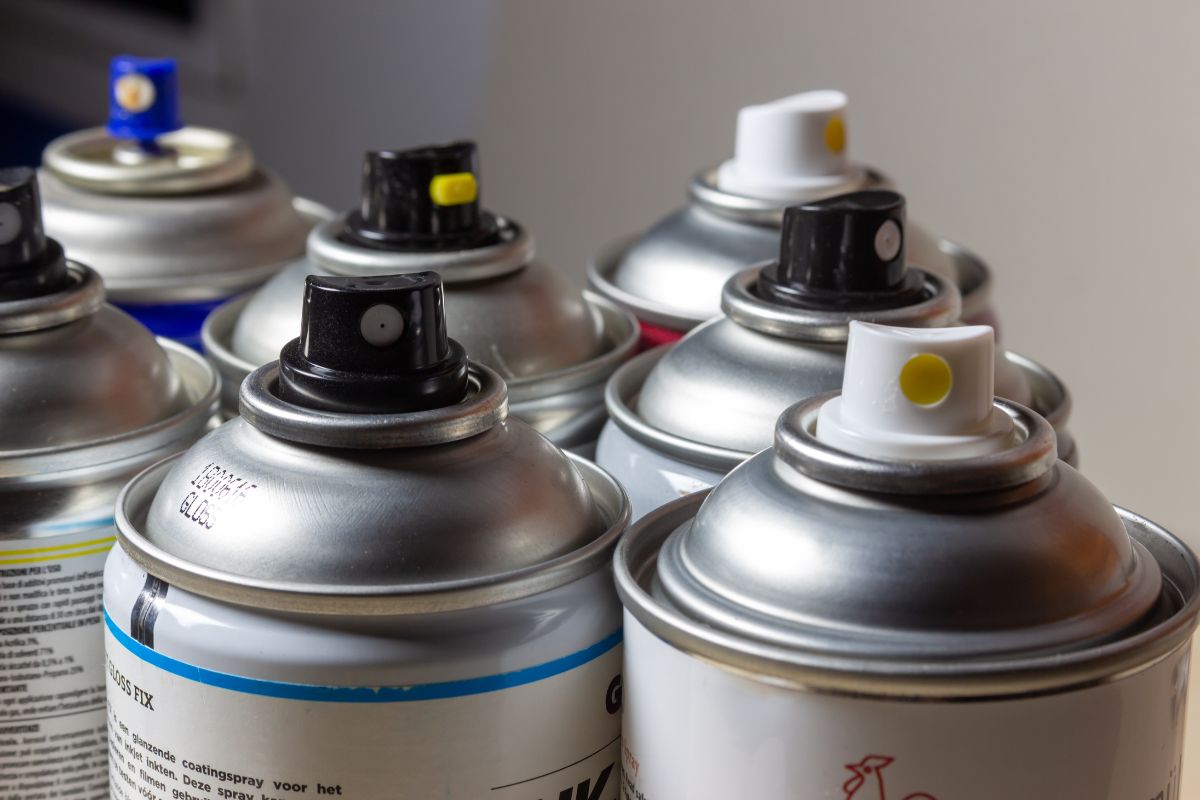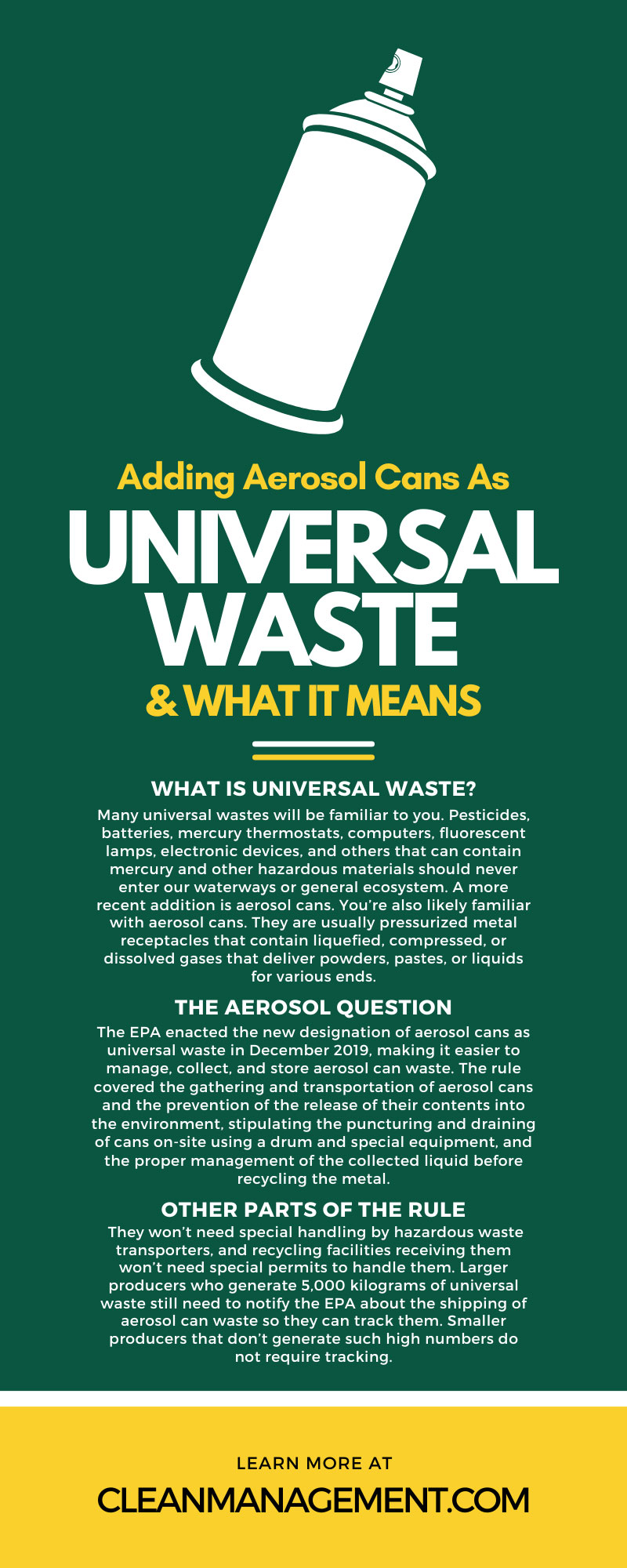Adding Aerosol Cans as Universal Waste & What It Means

Waste not, want not. Unfortunately, we still end up having to throw out the trash even if we try very hard not to waste things. Most waste is relatively safe, meaning it’s not immediately poisonous, hazardous, or generally dangerous to human beings and the environment. Hazardous waste receives strict regulation, and the EPA monitors its disposal to prevent disaster, environmental damage, health issues, and so forth. Still, some waste can be slightly hazardous while also being widespread. These items have earned the collective description of universal waste. The EPA describes universal waste as hazardous waste produced by households and businesses in small quantities. The EPA created these regulations to encourage recycling mostly while making it easier for people, businesses, and communities to collect and dispose of them without undue burden while ensuring they stay out of landfills. But there’s more to the EPA’s effort of adding aerosol cans as universal waste. Here’s what it means to you.
What Is Universal Waste?
Many universal wastes will be familiar to you. Pesticides, batteries, mercury thermostats, computers, fluorescent lamps, electronic devices, and others that can contain mercury and other hazardous materials should never enter our waterways or general ecosystem. A more recent addition is aerosol cans. You’re also likely familiar with aerosol cans. They are usually pressurized metal receptacles that contain liquefied, compressed, or dissolved gases that deliver powders, pastes, or liquids for various ends. One can use aerosols to apply or deliver hairspray, insecticide, air fresheners, paint, medicines, and more. While safe to use for their intended purposes, their contents are frequently flammable, poisonous, or otherwise unsafe. While empty unpressurized aerosol cans aren’t hazardous themselves and fit for recycling if they consist of aluminum or steel, they’re rarely entirely bereft of their products or entirely depressurized and thus pose a danger.
The Aerosol Question
While aerosol cans and their contents are hazardous, they aren’t as hazardous as some things, and thus skirt some of the EPA’s regulations for more dangerous waste. The EPA enacted the new designation of aerosol cans as universal waste in December 2019, making it easier to manage, collect, and store aerosol can waste. The rule covered the gathering and transportation of aerosol cans and the prevention of the release of their contents into the environment, stipulating the puncturing and draining of cans on-site using a drum and special equipment, and the proper management of the collected liquid before recycling the metal. Designating aerosol cans as universal waste was already in play in several states before the EPA ruling, but now they apply to all states.
Other Parts of the Rule
The rule added other requirements to make disposal easier and costs lower. Waste management facilities can store them for a year rather than 90 days, as required by larger generators of universal waste. This increased timeline alleviates the time crunch for smaller producers of cans. They won’t need special handling by hazardous waste transporters, and recycling facilities receiving them won’t need special permits to handle them. Larger producers who generate 5,000 kilograms of universal waste still need to notify the EPA about the shipping of aerosol can waste so they can track them. Smaller producers that don’t generate such high numbers do not require tracking. Interestingly, the EPA considers receptacles that dispense hazardous products without aerosols as universal waste, but ones that contain only gas are not. However, this consideration may change in the future. Even so, leaking aerosol cans require special packaging in closed containers. Waste handlers must pack them with absorbent materials or puncture and drain them as quickly as possible.
Obligations to One’s Employees
Generators, handlers, and recyclers must ensure that their employees are familiar with safety issues and practices regarding the handling of any kind of hazardous waste, and aerosol cans are no exception. Employees responsible for aerosol can disposal must know what they’re dealing with and how they must manage the cans at each point. Their education should cover proper handling, the use of personal protective equipment, potential hazards regarding exposure to the can’s contents or the potential for explosions or ignition, and finally, the procedures they must follow in case of an emergency. Of special note, handlers must not dilute, treat, or dispose of the resulting liquid waste themselves, though their employers can make exceptions.
Where To Put It All?
Are there rules about storing spent aerosol cans in the meantime? Absolutely. Until waste management facilities transport them away from the facility or puncture and drain them, they must store all aerosol cans in a cool dry area. Storing cans near a heat source or a place where they can potentially rust or experience punctures, crushing forces, and ruptures is dangerous. Managers must ensure each container is structurally sound with no opportunity for leakage, spills, or similar damage and risk. A firm plastic tub or other container is good, but a paper or cardboard box is not. Managers can retain leaky cans but should store them apart from others and pack them with absorbent material appropriate for the contained liquid. Labeling the box or bin as “Universal Waste—Aerosols” is best practice.
Puncturing Problems
Invest in a professional device if you plan to puncture cans on-site. These devices consist of an evacuation or puncturing chamber on top that releases gases and liquids into an attached drum. Do not attempt to crush cans yourself using tools, homemade puncturing devices, vehicles, compactors, or any similar methods. Be aware that some cans contain products that can interfere with or even ruin professional puncturing devices, namely glue and other adhesives, insulation foam, and the like. Waste management facility employees should conduct puncturing in well-ventilated spaces, far from heat sources, sparks, and similar conditions that can ignite flammable materials. They must wear gloves, safety goggles, and masks or breathing apparatuses that will protect their faces, lungs, hearts, and general health.
That’s the gist of what’s been happening since the EPA began adding aerosol cans as universal waste and what it means to you as a consumer, waste handler, or recycling facility. Looking for waste cleanup companies to help you deal with these and other waste disposal questions? Contact us for a consultation today!

